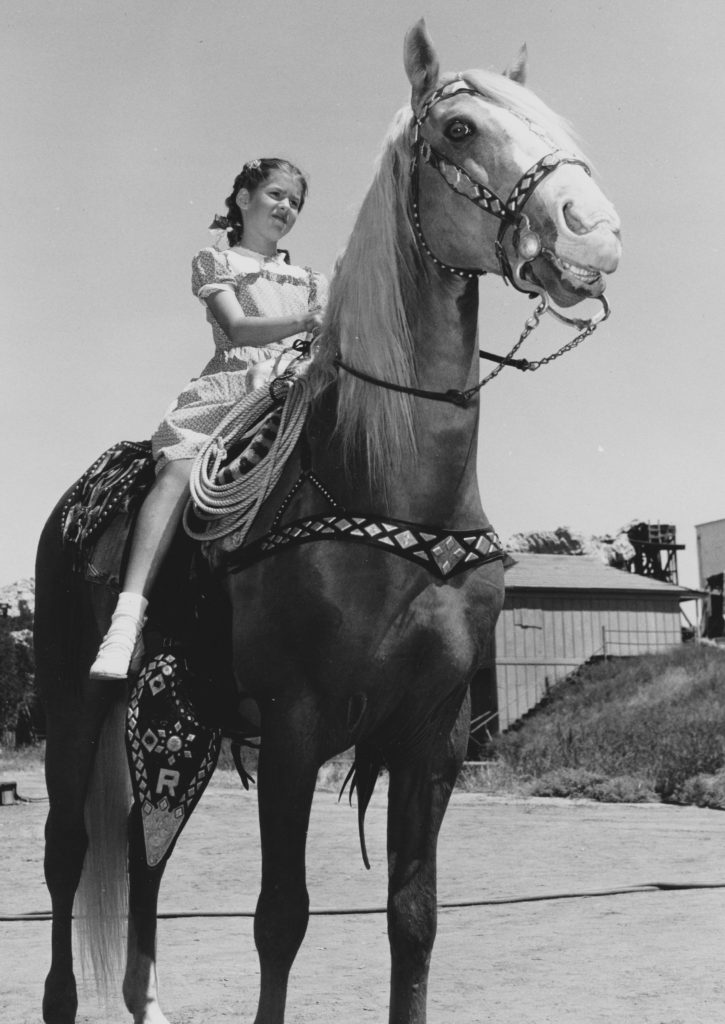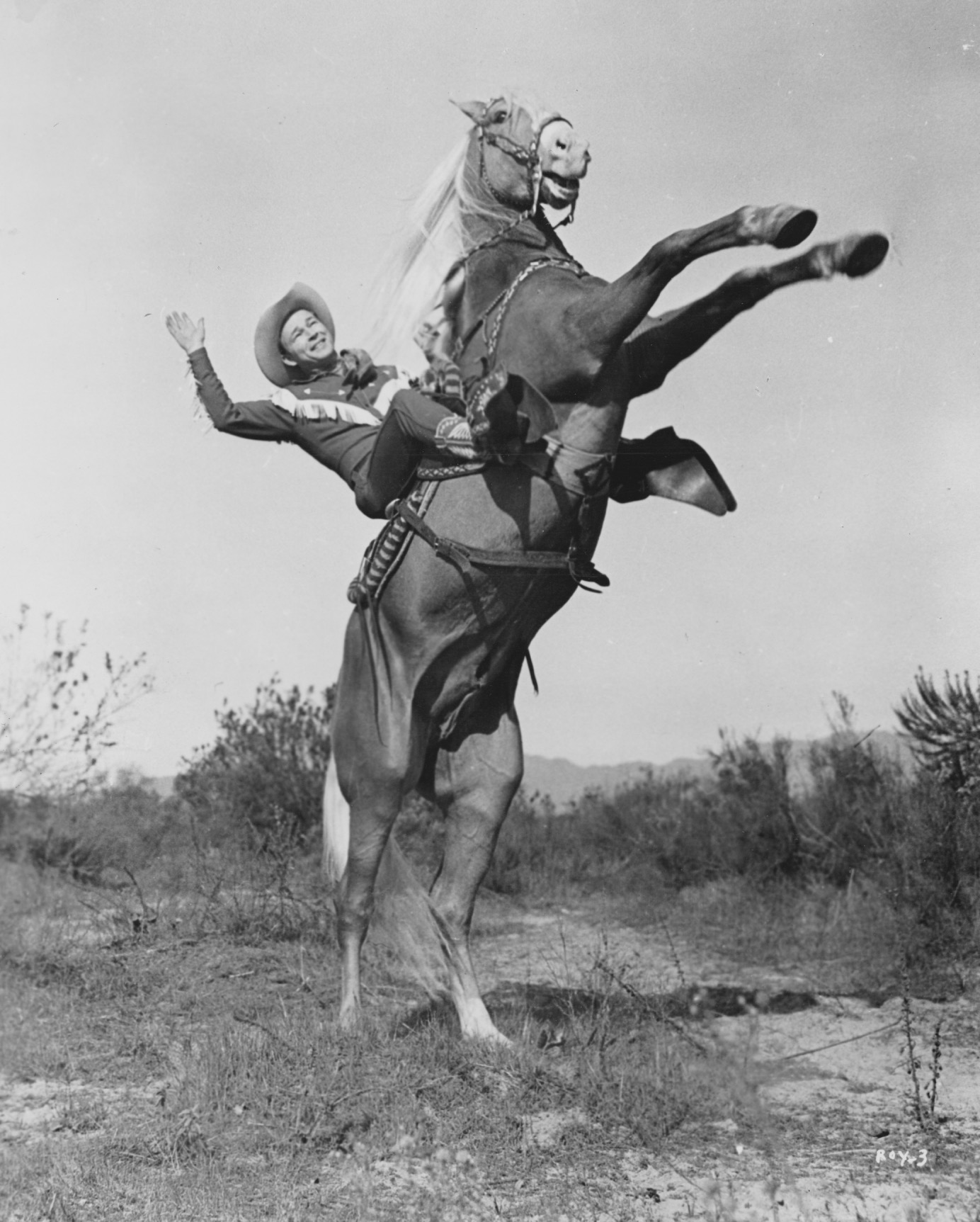Larry Z found a fabulous interview with my Dad (Roy Rogers) in the June 9, 1945 issue of the Saturday Evening Post (very popular magazine) . The interview was done by one of their top writers, Pete Martin, and is very long so I am going to post it in parts. I was only five when the interview was published and I think it is a very good interview. I think that most of it is actually what Dad told the reporter. However, I also think that some of it is from a handout that the PR department of Republic Studios wrote. I will put the part that I think the studio PR people handed out in italics. And, I will put my remarks in this dark blue. I hope you find the article interesting. I do.
CINCINNATI COWBOY by Pete Martin
When I told them at Republic that I had come to interview their palomino-horse movie star, Trigger, they assumed the badgered air of patient people who had seen writers come and go laden with such crackpot ideas that all surprise was dead. One of them said wearily, “In that case you might as well begin by trying to understand horse psychology. Just ask yourself where you’d go if you were a horse and you belonged to Roy Rogers, the King of the Cowboys, and it was a sunny morning with the light just right for making exterior shots. Then go there. You might find Trigger in one of his quiet moods.” He added, “We hope he doesn’t get up on the wrong side of his stall or something tomorrow morning.” There was a moment of silence. Then, by mutual consent, we tossed whimsey overboard. “It might be a good idea if Roy Rogers were on deck, too, so he can speak for Trigger if things begin to drag.” I compromised. Republic Pictures said that just possibly it might help. “You can breakfast at Iverson’s Ranch with the company on location,” I was told. “There’ll be a lunch wagon there.”
About the only thing Trigger can’t do is talk. He is practically a horse Quiz Kid. His contract with Republic specifies that he must have at least three close-ups in each picture and that he must help motivate the plot and have equal screen billing with his owner, Rogers. According to Republic’s people, Rogers has established an all-time record as a receiver of movie fan mail, topping by plenty Clara Bow’s previous high of 35,000 pieces a month. Rogers’ employers claim that in three months, 269,000 fanatical followers took the trouble to write to him. But Trigger also gets fan mail. The amount is naturally far below the mailbags full of correspondence his master received, but it is still fairly startling to think that more than 200 fans a month actually write to a horse.
Trigger has been known to dip his hoof into ink and autograph photographs of himself for his admirers. Annually, he celebrates his birthday by eating a cake topped with carrots in lieu of candles. Facing an audience brings out the ham in him, and when Rogers has had his fair share of applause, Trigger nudges him away from the microphone and breathes gustily into it himself. A wedding was planned for him in Madison Square Garden but, when the Garden management, with nicety of taste, decided that it wouldn’t be quite the thing to do, it was called off. He goes into hospitals to entertain wounded veterans. As an attraction he out-pulled Hedy Lamarr at a show held as part of an armament display at the Chrysler Building. A bomber with the American Air Force in Europe is named for him. And, during the course of a radio performance, he has even kissed a woman. For a horse, Trigged really gets around.
He knows fifty tricks (actually he had well over 100 tricks) —among them such feats as walking 150 feet on his hind legs, untying ropes, knocking on doors, cake-walking, backing up to a chair and sitting down on it, boxing with Roy or his trainer, firing a gun by pulling a handkerchief tied too its trigger, counting to ten, opening and closing doors, picking a gun from its holster, adding and subtracting, answering “yes” or “no,” tenderly covering Roy with a blanket and holding one end of a rope for skipping. When a script calls for Roy to be wounded, Trigger can lie down beside him long enough for his master to sprawl across the saddle, then get to his feet and gallop away with Rogers through what his trainer, Glenn Randall, calls “infested country” — infested by Indians or outlaws. Trigger can also pretend he is wounded by giving a convincing illusion of having a broken leg. Sometimes when Roy is “wounded,” the “wounded” Trigger lies down besides him and they both “die” together.
Most remarkable of all is the fact that Trigger has been completely house-broken — an extremely useful trick for a horse that spends a lot of time in hotel ballrooms, on theatrical stages and pushing wheelchairs around hospitals to the screeching delight of their small leg-brace wearing occupants. Neither Roy nor his trainer will talk much about this facet of Trigger’s talents. Their reticence is understandable, for how they taught him to be so well mannered is a trade secret. I found out about those things the previous day while boning up on “shootin’-gallery” pictures. Sitting in theaters I had listened to plenty of horses’ hooves drumming across the silver screen, but if I was to talk to a Western star, it seemed a bit wise to do special research into the finer points of this occupation.
A former publicity man for Western pictures helped with my skill practice. “There are certain unalterable rules that must be followed in making a Western,” he told me. “A cowboy star rarely kills anyone but the heavy. He may fight him, but he must never take unfair advantage of him or do anything underhanded to gain the victory. He must never kiss the girl or marry her. Kissing is “mushy.” He must ride away into the sunset alone, with no fringed skirt beside him. His private and personal life must be exemplary, for any hint of scandal will destroy him with the sub-subdeb, cap-pistol set and the boys who wear violently checked shirts hanging down outside of their trousers, who together make up the bulk of his following.” The OWI (Office of War Information) has even stepped in and helped make up rules for Westerns. Movie cowboys are no longer allowed to wear guns strapped to their hips all the time in pictures. Somebody in Washington conceived the notion that, when Westerns were shown abroad, people might get the idea that America was overrun by badmen and killers. So, now a cowboy like Rogers, can strap on his full armament in a motion picture only when he’s setting forth to knock-off a villain. “His lot however, has certain rewards,” my informant concluded. “He can live a life remote from Hollywood, which in itself is a break. The headwaiter at the Mocambo (a Hollywood nightclub) may not know him, but east of Pasadena he is as well known as General MacArthur. His social life is largely made up of playing poker with other celluloid buckaroos on a Saturday night or throwing a barbecue in his backyard. Every four years, on average, his audience renews itself. A new crop of kids comes along, which means that, everything being equal, he can keep on cashing in until advancing age forces him to give up riding horseback.”
In the pinfeather days (I’ve never heard that expression before) of talkie Westerns, it was customary not to give the leading lady any dialogue at all, since the pay for a speaking part was higher than that for an actress who kept mum. When a pursuing posse asked her, as they almost always did in the course of a horse opera, “Which way did they go, Ma’am?” she pointed silently after the fleeing desperadoes. Budgets are more elastic now and when a Western player is asked, “Which way did they go,” he or she is allowed to answer. Hollywood legend has it that such replies invariably consist of the phrase, “They went that-away.”

Look for Part 2 next week.

5 comments
Skip to comment form
This is great! How adorable that Trigger had his own PR and rightly so, what a special horse. I’m sad I only saw him at the museum. I can’t wait to see the rest, thank you. P.S. we have tickets to see brother Dusty in September in N. TX and sure hope it’s not cancelled, everybody stay well, God bless!
Sure enjoyed Part 1. Thanks ever so much for sharing with us!!! I admit the golden Palomino stole this little girl’s heart first and foremost but over the decades, Roy and Dale crept into my heart with their genuine and Christian life. I am so honored to have met them in Victorville for their 50th Anniversay!
I really enjoyed this first part and looking forward to the others. The writer obviously didn’t know there was more than one Trigger and when speaking of Trigger the comments were used interchangeably about Old Trigger and Little Trigger. From what I have read Old Trigger was in all Roy’s movies except the last two and Little Trigger went on tours etc. and actually did the most tricks. But that is okay because it was part of the mystical theme of Hollywood and pretend fantasy. No one ever claimed western heroes were real. That is why so many people loved Roy and Trigger. They took everyone to a pretend world we all wished was real because the good in people always won out over the bad.
Hi Cheryl …..,
These articles are always such a fun read. Thank you for sharing them.! Hope you have a wonderful & memorable Mother’s Day.!!
Jim & Patty Crawford
Enjoyed reading all the articles. Keep them coming!!!!